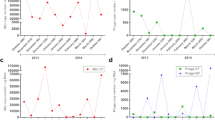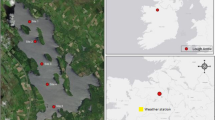Abstract
Little is known about the natural distribution of viruses that infect the photosynthetically important group of marine prokaryotes, the cyanobacteria. The current investigation reveals that the structure of cyanophage communities is dependent on water column structure. PCR was used to amplify a fragment of the cyanomyovirus gene (g) 20, which codes for the portal vertex protein. Denaturing gradient gel electrophoresis (DGGE) of PCR amplified g20 gene fragments was used to examine variations in cyanophage community structure in three inlets in British Columbia, Canada. Qualitative examination of denaturing gradient gels revealed cyanophage community patterns that reflected the physical structure of the water column as indicated by temperature and salinity. Based on mobility of PCR fragments in the DGGE gels, some cyanophages appeared to be widespread, while others were observed only at specific depths. Cyanophage communities within Salmon Inlet were more related to one another than to communities from either Malaspina Inlet or Pendrell Sound. As well, surface communities in Malaspina Inlet and Pendrell Sound were different when compared to communities at depth. In the same two locations, distinct differences in community composition were observed in communities that coincided with depths of high chlorophyll fluorescence. The observed community shifts over small distances (only a few meters in depth or inlets separated by less than 100 km) support the idea that cyanophage communities separated by small spatial scales develop independently of each other as a result isolation by water column stratification or land mass separation, which may ultimately lead to changes in the distribution or composition of the host community.






Similar content being viewed by others
References
O Bergh KY Børsheim G Bratbak M Heldal (1989) ArticleTitleHigh abundance of viruses found in aquatic environments. Nature 340 467–468 Occurrence Handle1:STN:280:BiaA3s%2FlvFU%3D Occurrence Handle2755508
G Bratbak M Heldal S Norland TF Thingstad (1990) ArticleTitleViruses as partners in spring bloom microbial trophodynamics. Appl Environ Microbiol 56 1400–1405
F Chen CA Suttle SM Short (1996) ArticleTitleGenetic diversity in marine algal virus communities as revealed by sequence analysis of DNA polymerase genes. Appl Environ Microbiol 62 2869–2874 Occurrence Handle1:CAS:528:DyaK28Xkslegu7k%3D Occurrence Handle8702280
JA Fuhrman (1992) Bacterioplankton roles in cycling of organic matter: the microbial food web. PG Falkowski AD Woodhead (Eds) Primary Productivity and Biogeochemical Cycles in the Sea. Plenum Press New York 361–383
NJ Fuller WH Wilson IR Joint NH Mann (1998) ArticleTitleOccurrence of a sequence in marine cyanophages similar to that of T4 g20 and its application to PCR-based detection and quantification techniques. Appl Environ Microbiol 64 2051–2060 Occurrence Handle1:CAS:528:DyaK1cXjslWhsL4%3D Occurrence Handle9603813
HE Glover (1985) ArticleTitleThe physiology and ecology of the marine cyanobacterial genus Synechococcus. Adv Aquat Microbiol 3 49–107
MJ Hall SD Wharam A Weston DLN Cardy WH Wilson (2002) ArticleTitleUse of signal-mediated amplification of RNA technology (SMART) to detect marine cyanophage DNA. Biotechniques 32 604–611 Occurrence Handle1:CAS:528:DC%2BD38XitFCnsb8%3D Occurrence Handle11926174
E Hambly F Tetart C Desplats WH Wilson HM Krisch NH Mann (2001) ArticleTitleA conserved genetic module that encodes the major virion components in both the coliphage T4 and the marine cyanophage S-PM2. Proc Natl Acad Sci USA 98 11411–11416 Occurrence Handle10.1073/pnas.191174498 Occurrence Handle1:CAS:528:DC%2BD3MXnt1yqur0%3D Occurrence Handle11553768
KP Hennes CA Suttle (1995) ArticleTitleDirect counts of viruses in natural-waters and laboratory cultures by epifluorescence microscopy. Limnol Oceanogr 40 1050–1055 Occurrence Handle1:CAS:528:DyaK2MXpsVCrtb0%3D
KP Hennes CA Suttle AM Chan (1995) ArticleTitleFluorescently labelled virus probes show that natural virus populations can control the structure of marine microbial communities. Appl Environ Microb 61 3623–3627 Occurrence Handle1:CAS:528:DyaK2MXosFGmsr0%3D
MA Hurley ME Roscoe (1983) ArticleTitleAutomated statistical analysis of microbial enumeration by dilution series. J Appl Bacteriol 55 159–164
R Iturriaga J Marra (1988) ArticleTitleTemporal and spatial variability of chroococcoid cyanobacteria Synechococcus spp. specific growth rates and their contribution to primary production in the Sargasso Sea. Mar Ecol Prog Ser 44 175–181
CA Kellogg JB Rose SC Jiang JM Thurmond JH Paul (1995) ArticleTitleGenetic diversity of related vibriophages isolated from marine environments around Florida and Hawaii, USA. Mar Ecol Prog Ser 120 89–98
WKW Li DV Subba Rao WG Harrison (1983) ArticleTitleAutotrophic picoplankton in the tropical ocean. Science 219 292–295
J Lu F Chen RE Hodson (2001) ArticleTitleDistribution, isolation, host specificity, and diversity of cyanophages infecting marine Synechococcus spp. in river estuaries. Appl Environ Microbiol 67 3285–3290 Occurrence Handle10.1128/AEM.67.7.3285-3290.2001 Occurrence Handle1:CAS:528:DC%2BD3MXkvFSms74%3D Occurrence Handle11425754
L McDaniel LA Houchin SJ Williamson JH Paul (2002) ArticleTitleLysogeny in marine Synechococcus. Nature 415 496 Occurrence Handle10.1038/415496a Occurrence Handle1:CAS:528:DC%2BD38Xht1Gis7g%3D Occurrence Handle11823851
M Middelboe A Hagstrom N Blackburn B Sinn U Fischer NH Borch J Pinhassi K Simu MG Lorenz (2001) ArticleTitleEffects of bacteriophages on the population dynamics of four strains of pelagic marine bacteria. Microb Ecol 42 395–406 Occurrence Handle1:CAS:528:DC%2BD38Xks1w%3D Occurrence Handle12024264
AC Ortmann JE Lawrence CA Suttle (2002) ArticleTitleLysogeny and lytic viral production during a bloom of the cyanobacterium Synechococcus spp. Microb Ecol 43 225–231 Occurrence Handle1:CAS:528:DC%2BD38Xks1Wqu7c%3D Occurrence Handle12023729
LM Proctor JA Fuhrman (1990) ArticleTitleViral mortality of marine bacteria and cyanobacteria. Nature 343 60–62 Occurrence Handle10.1038/343060a0
SM Short CA Suttle (2000) ArticleTitleDenaturing gradient gel electrophoresis resolves virus sequences amplified with degenerate primers. Biotechniques 28 20–26 Occurrence Handle1:CAS:528:DC%2BD3cXlt1amug%3D%3D Occurrence Handle10649762
SM Short CA Suttle (2002) ArticleTitleSequence analysis of marine virus communities reveals that groups of related algal viruses are widely distributed in nature. Appl Environ Microbiol 68 1290–1296 Occurrence Handle10.1128/AEM.68.3.1290-1296.2002 Occurrence Handle1:CAS:528:DC%2BD38XitFSjs70%3D Occurrence Handle11872479
CA Suttle (1994) ArticleTitleThe significance of viruses to mortality in aquatic microbial communities. Microb Ecol 28 237–243
CA Suttle (2000) Cyanophages and their role in the ecology of cyanobacteria. BA Whitton M Potts (Eds) The Ecology of Cyanobacteria. Kluwer Academic Publishers Netherlands 563–589
CA Suttle AM Chan (1993) ArticleTitleMarine cyanophages infecting oceanic and coastal strains of Synechococcus—abundance, morphology, cross-infectivity and growth characteristics. Mar Ecol Prog Ser 92 99–109
CA Suttle AM Chan (1994) ArticleTitleDynamics and distribution of cyanophages and their effect on marine Synechococcus spp. Appl Environ Microbiol 60 3167–3174
CA Suttle AM Chan MT Cottrell (1990) ArticleTitleInfection of phytoplankton by viruses and reduction of primary productivity. Nature 347 467–469 Occurrence Handle10.1038/347467a0
CA Suttle AM Chan MT Cottrell (1991) ArticleTitleUse of ultrafiltration to isolate viruses from seawater which are pathogens of marine phytoplankton. Appl Environ Microb 57 721–726
TF Thingstad (2000) ArticleTitleElements of a theory for the mechanisms controlling abundance, diversity, and biogeochemical role of lytic bacterial viruses in aquatic systems. Limnol Oceanogr 45 1320–1328
JB Waterbury FW Valois (1993) ArticleTitleResistance to co-occurring phages enables marine Synechococcus communities to coexist with cyanophages abundant in seawater. Appl Environ Microbiol 59 3393–3399
JB Waterbury SW Watson FW Valois DG Franks (1986) ArticleTitleBiological and ecological characterization of the marine unicellular cyanobacterium Synechococcus. Can Bull Fish Aquat Sci 214 71–120
SW Wilhelm CA Suttle (1999) ArticleTitleViruses and nutrient cycles in the sea—viruses play critical roles in the structure and function of aquatic food webs. Bioscience 49 781–788
Wilson WH, Fuller NJ, Joint IR, Mann NH (1999) Analysis of cyanophage diversity and population structure in a south-north transect of the Atlantic Ocean. Special issue no. 19, Bulletin de l’Institut Oceanographique, Monaco, pp 209–216
WH Wilson IR Joint NG Carr NH Mann (1993) ArticleTitleIsolation and molecular characterization of five marine cyanophages propagated on Synechococcus sp. strain WH7803. Appl Environ Microbiol 59 3736–3743 Occurrence Handle1:CAS:528:DyaK2cXislWjtA%3D%3D
WH Wilson NJ Fuller IR Joint NH Mann (2000) Analysis of cyanophage diversity in the marine environment using denaturing gradient gel electrophoresis. Microbial Biosystems: New Frontiers. Proceedings of the 8th International Symposium Microbial Ecology Halifax, Nova Scotia, Canada 1999 565–571
KE Wommack RR Colwell (2000) ArticleTitleVirioplankton: viruses in aquatic ecosystems. Microbiol Mol Biol R 64 69–114 Occurrence Handle10.1128/MMBR.64.1.69-114.2000 Occurrence Handle1:STN:280:DC%2BD3c7ntF2jsw%3D%3D Occurrence Handle10704475
KE Wommack J Ravel RT Hill JS Chun RR Colwell (1999) ArticleTitlePopulation dynamics of Chesapeake Bay virioplankton: total community analysis by pulsed-field gel electrophoresis. Appl Environ Microbiol 65 231–240 Occurrence Handle9872784
Y Zhong F Chen SW Wilhelm L Poorvin RE Hodson (2002) ArticleTitlePhylogenetic diversity of marine cyanophage isolates and natural virus communities as revealed by sequences of viral capsid assembly protein gene g20. Appl Environ Microbiol 68 1576–1584 Occurrence Handle10.1128/AEM.68.4.1576-1584.2002 Occurrence Handle1:CAS:528:DC%2BD38XivFGltrg%3D Occurrence Handle11916671
Acknowledgements
The authors gratefully acknowledge Alice Ortmann for virus slide preparation, Sean Brigden for providing the cyanobacteria host DC-2, and Andre Comeau for the preparation of the cruise log. We also thank the crew of the CCGS Vector for their assistance with sample collection and Sara Leckie for her help with Gel Compar II. This study was supported by a grant from the Natural Sciences and Engineering Research Council of Canada (NSERC) to C.A. Suttle.
Author information
Authors and Affiliations
Corresponding author
Rights and permissions
About this article
Cite this article
Frederickson, C., Short, S. & Suttle, C. The Physical Environment Affects Cyanophage Communities in British Columbia Inlets . Microb Ecol 46, 348–357 (2003). https://doi.org/10.1007/s00248-003-1010-2
Received:
Accepted:
Published:
Issue Date:
DOI: https://doi.org/10.1007/s00248-003-1010-2




